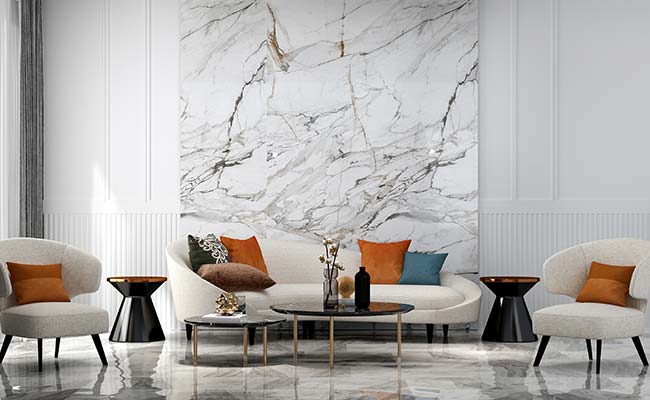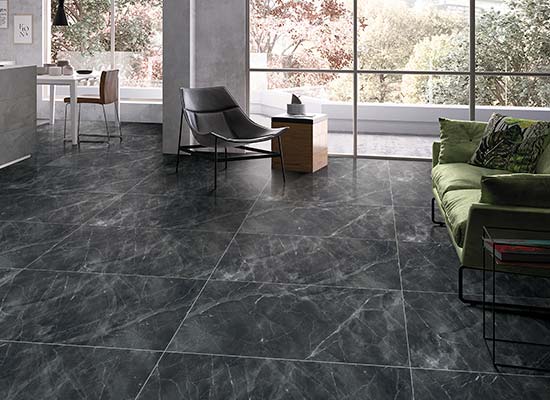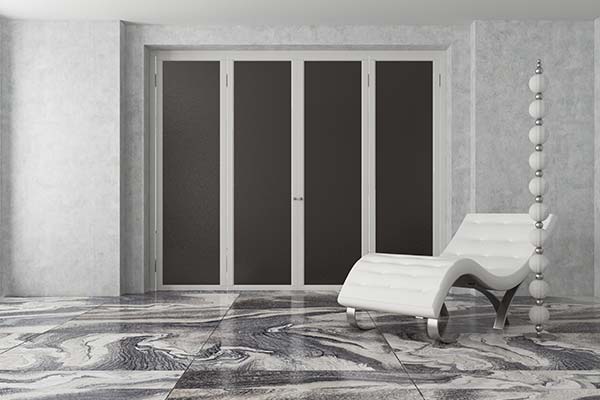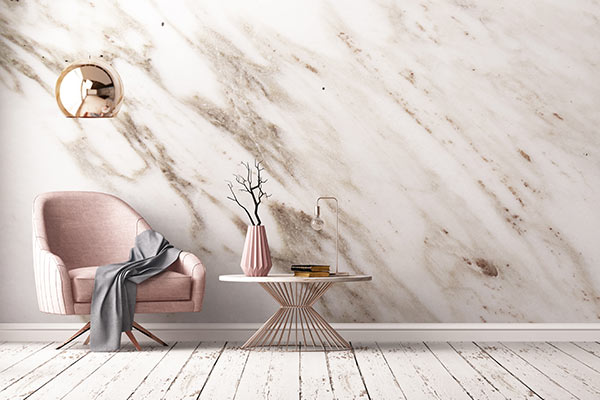
Marble floor tiles and natural marble stone often compete for space in building interiors. Marble is a natural stone that adds a touch of beauty and uniqueness to wherever it is used. It is a timeless material that has been utilised for ages by architects and interior designers all over the world to exude a sense of luxury.
Marble is a versatile stone that can be utilised anywhere, from monuments to sculptures to opulent interiors. It may provide a traditional yet simplistic aesthetic that can elevate any space.
Marble floor tiles come in several sizes, from little to enormous, allowing you to effortlessly design your space to your preference. There are numerous ways to install marble floor and wall tiles, including regular, irregular, Versailles, and brick patterns. Overall, going with marble tiles might be a terrific choice for you.
Marble Floor Tiles

Marble tiles are incredibly adaptable and can be used on walls and floors alike. Any area, including the living room, dining room, kitchen, bathroom floors, study, or prayer room, can use them.
Marble tiles are suitable for all settings, whether they are residential or commercial, as they are offered in vitrified, ceramic, and double-charge varieties in both matte and glossy finishes.
In general, marble tiles typically have veins running through them that give them a distinctive appearance. This implies that you can also choose tiles where no two tiles are visually identical.

Additionally, there are a variety of colours and patterns to choose from. For instance, white marble tiles typically contain grey striations that give them an almost luminous appearance. However, cream-coloured marble tiles give off a cosy and pleasant appearance.
Marble Stone

If you want a luxurious and ancient atmosphere, marble is a great choice because it is timeless and quite durable. Marble is tough and available in a huge variety of designs and hues. Darker hues of marble are also distinctly lovely, yet pure white marble has a more immaculate appearance. Given that it is made of high-end material in terms of beauty and price, the living room is the ideal location to showcase it.
Marble Floor Tiles vs Marble Stone
When comparing tiles and marbles, you will undoubtedly choose the former. When compared to the cost of raw marble stone, marble tile prices are more affordable.
Not only that, but natural marble is difficult to keep, whereas marble tiles are not. Marble tiles will provide the same elegance with far less effort on the user's behalf.
Because they are lighter than natural stones, they are also easier to install. Furthermore, the cost of marble tiles is substantially lower than that of stones.
| Marble Stone | Marble Tiles |
|---|---|
Quarried from naturally occurring sites | Manufactured using natural materials like clay and sand |
Requires on-site cutting and polish | Available in a pre-cut and polished format |
Needs regular maintenance and polishing to seal off pores | GVT is nonporous with negligible water absorption |
Imported stones cost extremely high | Replicates unique natural and designed formats without affecting the price |
Stains need immediate treatment to avoid permanent discolouration | A regular wipe with warm soapy water is enough to keep the tiles in pristine conditions |
Preferred as a kitchen countertop and floor tile as it works as a natural thermal jacket | Large format tiles are available for countertop applications, thermal properties are the same or even better than marble |
Making the best decision and selecting the solution that best suits your needs will be made easier for you if you are aware of the distinctions mentioned below:
- Composition
When limestone undergoes metamorphic crystallisation, calcium carbonate is transformed into calcite crystals, creating marble, a natural stone. In contrast, floor tiles are made of silicates or clay that has been heated to a high temperature.
- No stains
The stain-proof characteristic is another element that distinguishes both choices from one another. Tiles are easy to keep and don't discolour as marble does, which makes them a better alternative.
- Classifications
The numerous tints and colours of marble are a result of the geographical formation processes that took place. Additionally, tiles come in a variety of materials, including terra cotta, quarry tiles, glass, and even porcelain. These choices can be utilised as wall and floor tiles.
- Price
Tiles are less expensive than marble. This is so because while marble is a natural stone, tiles are man-made and require expensive mining and extraction techniques. Additionally, only expensive, high-quality marble has a good aesthetic and is very expensive.
- Wastage
Waste because so much marble is lost when it is cut into the proper sizes, the price of marble continues to rise. Tiles are less expensive to install than marble stone since there is less wastage.
- Finish
In contrast to polished marble, which has a glossy appearance and can be tumbled or honed, tiles come in both glazed and unglazed varieties. It has a natural-looking design screen printed onto its surface.
- Porosity
When compared to tiles, marble has a comparatively high porosity because it is a stone with a strong crystalline structure. Marble may therefore be polished to a high gloss. Tiles are perfect for usage in areas with a lot of wetness, such as bathrooms, and kitchens, because they have relatively low porosity.
- Eco-Friendly
Since marble is a non-renewable resource and its extraction requires energy-intensive procedures, it cannot be regarded as an environmentally beneficial choice. The environment is irreversibly impacted by these processes. In contrast, tiles outperform marble because they can be recycled, are non-toxic, and are produced under controlled conditions.
- Variation
The appearance and colour of the tiles are meticulously regulated during production, resulting in a product with a few very minute variances across batches. Contrarily, marble is a natural stone, and as such, there can be significant variations within a single stone from the same lot. Marble is less consistent than tiles for the same reason.
Marble Wall & Floor Tiles for an Eco-Friendly Solution
Marble is a timeless and fashionable material that frequently looks well with a wide range of styles and aesthetics. However, glazed vitrified tiles offer irresistible solutions for traditional, contemporary, or mixed-themed interiors.
With better durability, affordable range and low maintenance marble tiles can replicate your marble interior of any imagination.
Frequently Asked Questions
Marble is a metamorphic rock which is a limestone buried for a million years or more under the earth. The heat and pressure transform the rock into a sparkling lustrous stone which we call marble. It is usually available in pink, white, grey, red, yellow, and black colours.
Yes. Even though marble is a tough stone, when you are using it in areas with the possibility of spillage and wetness, you need to wax it regularly. Marble is a porous stone, which can absorb liquid. Thus, a non-polished/waxed stone can gather stains from absorbing liquid and moisture. Marble surfaces like a countertop, bathroom floors, etc. need regular sealing for longevity.
Marble is a natural insulator and helps regulate the interior temperature. Marble, like many other natural stones, can offer heat resistance up to 350-degree Fahrenheit. That is why it is also a popular material to use as a countertop.
Yes, cooking pans can carry a temperature ranging from 100-120 degrees Celsius. This is easily under the tolerance limit for marble stone which can offer insulation from temperatures up to 175 degrees Celsius.